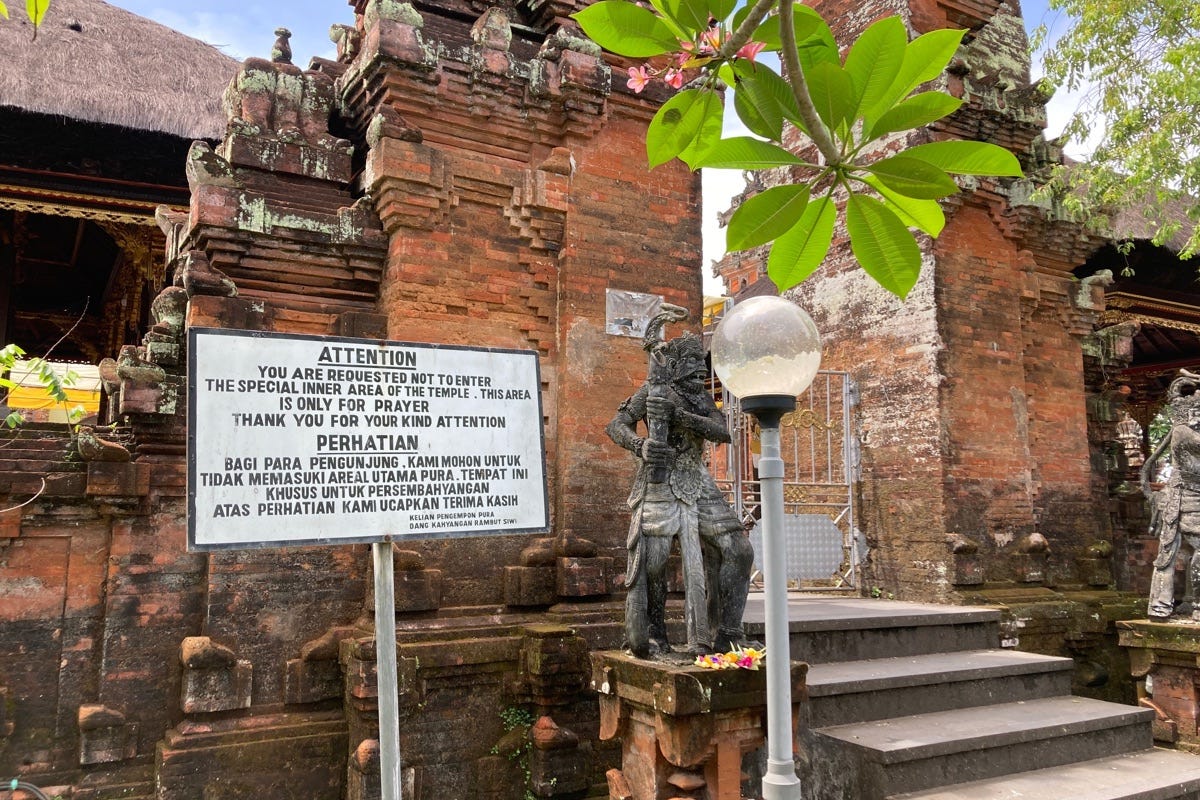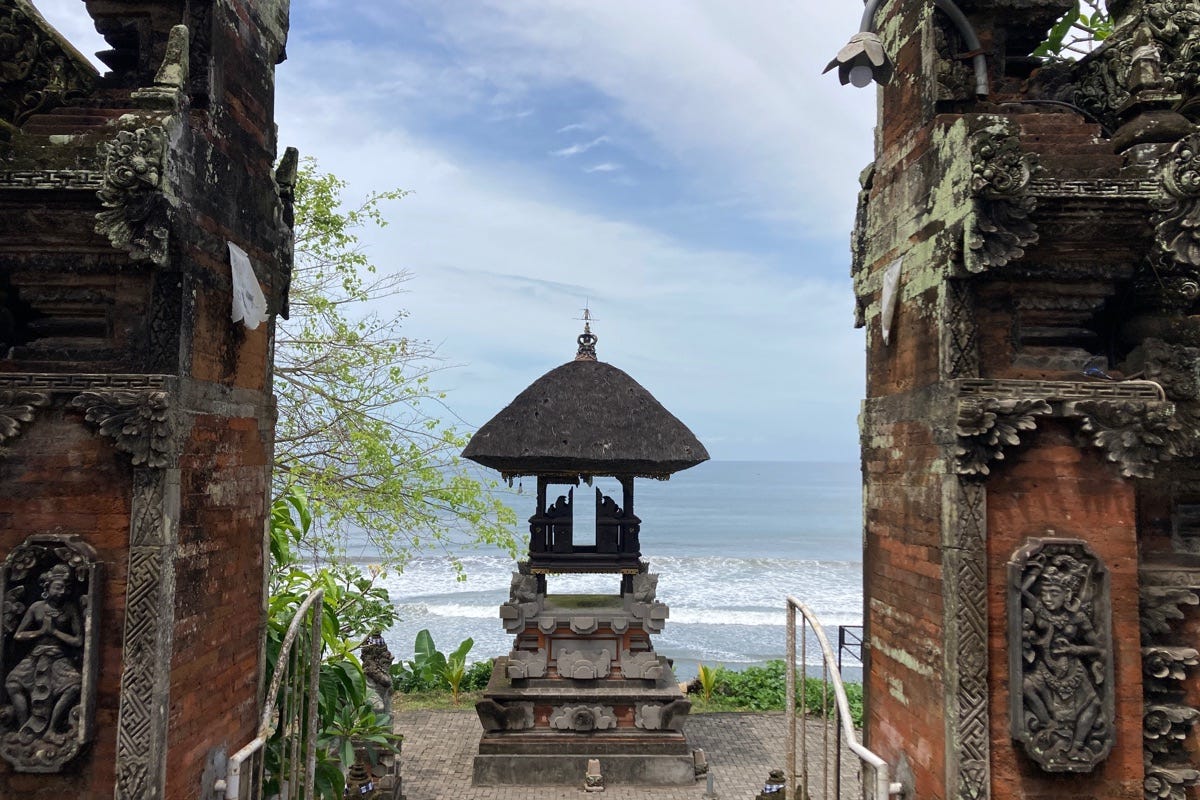A few years ago, in the late 15th century, as Islam supplanted Java’s Majapahit Empire, Java’s Hindus edged east. For a spell, they clung to Java’s eastern reaches, especially around modern-day Banyuwangi, but over time, most crossed the Bali Strait to, well, Bali.
One of those making up the eastward move was Dang Hyang Niratha. A Shiva-Buddhist high priest, with purported psychic and supernatural powers, he made the crossing in 1489, 1537 or 1546 (accounts vary). There were no car ferries back then, so he made the crossing on the back of a pumpkin or a breadfruit tree leaf—again accounts vary. As an aside, one pumpkin source suggests this is the root of why Balinese Brahmin refrain from eating pumpkin. To my knowledge, no such ban on breadfruit exists—it must have been a pumpkin then, I guess.
I came by neither pumpkin nor breadfruit leaf. Photo: Stuart McDonald.
Accounts are more settled on where he landed, along a coastal strip by Negara in West Bali. Once on terra firma, he enjoyed a spell beneath a fig tree. To commemorate his landing, his followers built Pura Ancak (fig is ancak in Balinese) on the very site. A temple known for its white coral construction, it later became Pura Purancak. It was to be the first of many temples in Bali associated with Niratha.
Aside from his supernatural tendencies, Niratha was also a keen wanderer. Once he was well rested, he got going.
I’ve not been able to find a list of all the temples associated with Niratha, but some of Bali’s greatest, including Rambut Siwi, Tanah Lot and Uluwatu, are. It was at the latter where he attained moksha, and was freed from the shackles of reincarnation. After his “elevation,” luhur was added to the temple’s name. Uluwatu is a combination of ulu (end) and watu (stone), which, if you’ve ever been to Uluwatu, makes perfect sense. In adding luhur (go up/rise/above), the temple’s full name Pura Luhur Uluwatu is, in essence, a description of what became of Niratha and where it happened.
Soaking up Balinese culture by one of the holiest temples on the island, Pura Luhur Uluwatu. Photo: Sally Arnold.
Some time after landing in Bali, though before he reached the south, he grabbed a haircut at a scenic headland west of Medewi. A remnant of those cuttings is retained on site at Pura Rambut Siwi, a particularly magical spot. Moving on east, he plunged his staff into the waters of the Balian River, giving it healing properties. Today, pesky bull sharks on occasion savage surfers at the break out from Balian River’s mouth. I’m told the sharks head upriver when they’re feeling off, so perhaps Niratha had them in mind.
Niratha wasn’t only the mover and shaker behind some of Bali’s greatest temples. Lesser known ones, including Pura Petitenget in the heart of Seminyak, owe their origins to his wanderings and keepsakes. The temple’s name, from Balinese peti for small box and tenget for sorcery, is a reference to Niratha’s betel nut holder which he left with a resident spirit as he made his way to Uluwatu.
On ceremony days, this staircase is a sight to be seen. At Pura Rambut Siwi. Photo: Stuart McDonald.
Pura Purancak, Rambut Siwi, Tanah Lot and Uluwatu (along with a few others) are Bali’s “sea temples.” They’re strung along the coast, in theory within sight of one another, forming a coastal protective belt against evil spirits.
So where am I going with this?
A few months ago I started working on what I thought would be a quick story on the treatment of Islamic sites in Southeast Asia by travel publications. There’s no end in sight to me finishing that one, but I have been dwelling a lot on houses of worship—of all faiths.
While I’ve used Bali in the example above, I could as easily weave a tale around sites of other faiths from elsewhere. The above information was not, as it turned out, easy to find. Even the simplest point—did Niratha travel by pumpkin or breadfruit leaf—is up for debate.
Tell me something I don’t know. Photo: Stuart McDonald.
What isn’t up for debate is that across the region, the mantra we hear daily, details a desire for “quality tourists.” While many believe this is shorthand for big-spenders, I’ve been wondering what a quality tourist is.
Is a quality tourist a bigger spender? Many think so. What about a more responsible tourist? One that travels in a more sustainable manner? A slow tourist? A short-stay tourist? Or are longer stays better? It’s a crapshoot and a highway to boring and droll straw man whataboutisms.
I do think there is one facet of a tourist that could be broadly agreed upon as being an element of quality. That is, a desire to learn about where they are.
Why should learning about a place be an indicator of quality? I’d argue for at least three reasons. It educates the traveller, which should help them to understand why things are as they are. This in turn should translate into a better trip for them. A destination-educated tourist should be more aware of cultural norms, and that is good for residents.
A different type of quality. Photo: Stuart McDonald.
One of the core ways to begin to understand a nation is to have a handle on the various faiths of its people. Comprehending why people behave as they do due to religious beliefs can explain a lot. Done sensitively and with the cooperation of worshippers, places of worship could be the perfect place to start down this road. To help tourists understand unfamiliar practices, and to learn the what, the how, and the why.
Yet, broad strokes, go to any house of worship, of any faith, anywhere in Southeast Asia, and they’ll be little of this. There may be a signboard explaining how to dress and what areas are off limits, but it generally stops there. Of course this signage is important, but come on, tell me something I don’t know—tell me about the temple. Often a visit is little more than either gawking at, or ignoring, devotees. Temple visits done bad tend to be very bad.
This seems like a missed opportunity. Two of the Bali’s “sea temples,” Uluwatu and Tanah Lot, are over the top popular. Yet most foreign tourists go not to learn. Instead it’s a sunset selfie, a contrived tourist spectacle, to buy tacky imported souvenirs, or to be savaged by macaques. In their own way, these are all lessons on why Bali is how it is, but these are not the lessons I’m thinking of.
Not a macaque in sight—just waves rolling in and Java beyond. Photo: Stuart McDonald.
I went to Pura Rambut Siwi this morning, as it is down the beach from where I am staying. When I told a Balinese friend I’d leased a house near the temple, she said “Ohhh so magical.” She was right, it is a stunning spot, atop a headland overlooking the breaking surf with Java in the distance. The grounds are pretty, and there is no shortage of meditative spots. Save the lady who took my 20,000 rupiah and furnished me with a sash and sarong, there wasn’t another soul there.
There also wasn’t anything about Niratha, Bali’s sea temples, or the relationship between them. Near the entrance there is a beautiful, ancient-looking tree, with a shrine beside it. There’s no explanation of the shrine’s purpose, but it was easy to imagine Niratha beneath the tree, gazing to the sea, as his locks fell to the ground. In other words, the interpretation of the site was left entirely to me.
These temples are religious and pilgrimage sites for Balinese Hindus. They are important and revered. They are the places people visit at pivotal moments through their lives. They matter. So of course, caution must be taken to tread with care. I’m not suggesting that tour buses should start clogging temple carparks. We all know how that works—look no further than the tourist circuses at Uluwatu or Tanah Lot. Around the world, religious sites are over-run by tourists behaving badly. Nobody needs more of that.
Come for the temple—stay for everything else. Photo: Stuart McDonald.
With the right steerage though, directed to the right people, there is an opportunity of sorts here. Not only to educate tourists, but to get them out of their tourist hubs. It can’t be about the temples and nothing else. Who hasn’t been to Europe and vomited a little bit in their mouth at the suggestion of another church? The churches though, are the bookends between shelf upon shelf of destinations. There’s no reason why it should be any different in Southeast Asia. I’ve written about Bali here, but this could be as much an outline for sights anywhere in the region. Give tourists the tools to help them get more out of their trip—in a sensitive and responsible manner—and introduce them to new destinations while you are at it.
Why couldn’t a trip to Bali retrace Niratha’s stroll. Each temple has its own unique setting and its own community with its own characteristics. Each is within easy reach of hotels and the other trappings most tourists want. Each could also serve to reinforce some point of understanding about Balinese culture. Bali is after all, supposedly a cultural destination.
My “house beach” from the temple. No, I am not complaining. Photo: Stuart McDonald.
Yes, guiding standards across Southeast Asia need vast improvement. But guiding is political—no element plays a larger role in steering a tourist’s interpretation. Good guides matter. Yet one doesn’t need to reinvent an entire educational system as a first step. Instead, how about some signboards? Some storytelling? I don’t know, title them “Niratha’s wanderings.” Each board could have a map, Niratha’s story, and the role each temple played in it. This need not be a huge nor costly undertaking—big things can start small.
Just settle on breadfruit or pumpkin before you go to the printers.
Couchfish is 100 per cent independent and reader-supported. If you’re not already a subscriber, and you’d like to show your support, become a paying subscriber today for just US$7 per month—you can find out more about Couchfish here—or simply share this story with a friend.
Don’t forget, you can find the free podcasts on Apple, Pocket Casts and Spotify as well as right here on Couchfish.


















